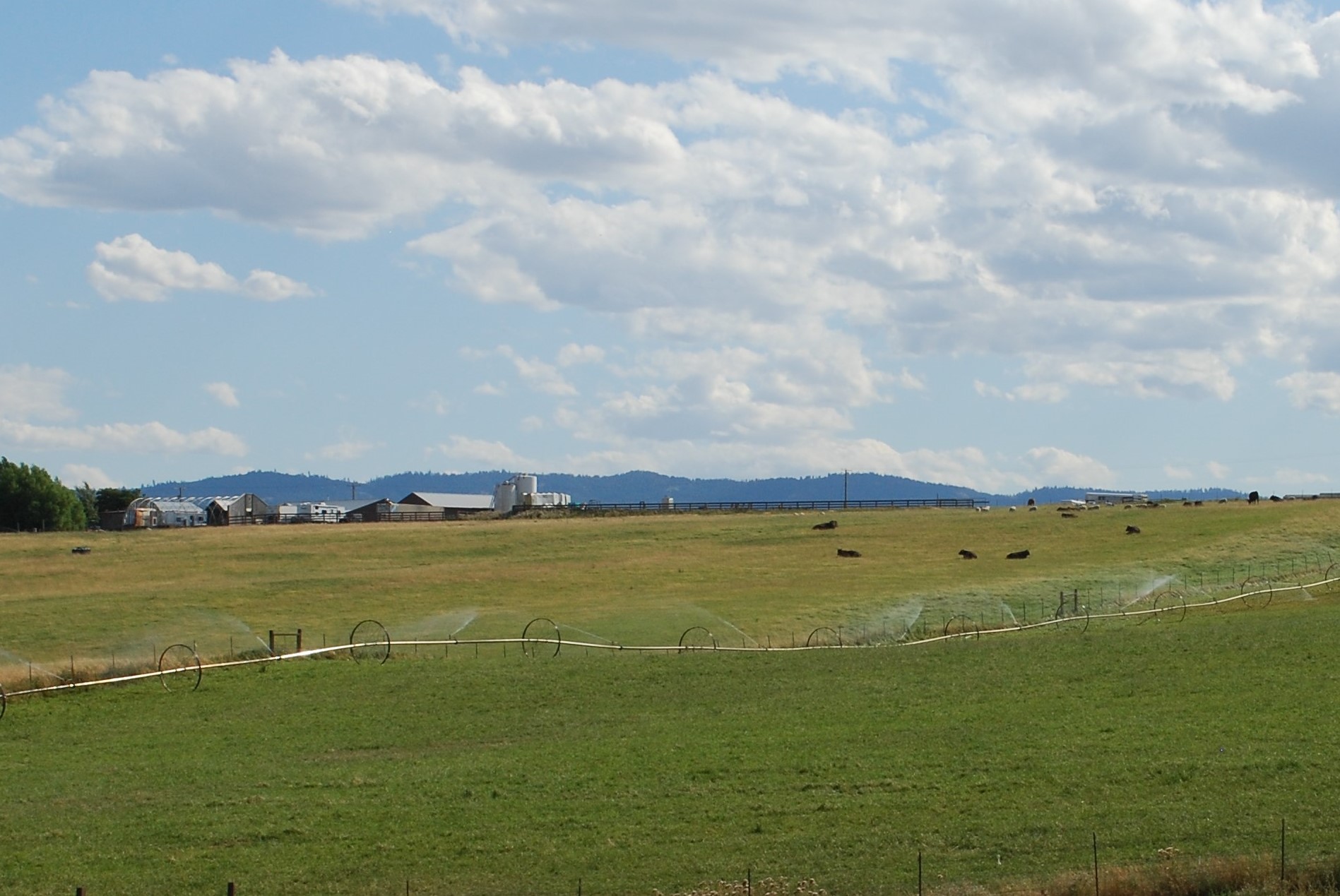
What is the difference between organic and non-organic beef?
Consider the origin story of your steak. Did the cow live in a crowded, stressful environment? Was its winter feed purchased or raised? Read more to learn about the differences between organic and non-organic beef, and how to properly source organic product.
When it comes to beef, the spectrum of possibility is wide and the consequences for environmental impact, animal welfare, and even nutrition are profound. All authentic organic beef is free from chemical inputs. Organic cattle are required to spend some portion of their lives (more on that later) on certified organic pasture, managed with a legally required organic systems plan to protect soil and water quality. Their feed must be certified organic, meaning it is non-GMO and free of harmful chemicals.
For more information on the organic beef marketplace, read the rest of Cornucopia’s Organic Beef Report.
How is conventional beef raised?
The majority of beef raised in the United States comes from industrialized conventional agriculture. The factory farm model evokes a dystopian novel. It confines cattle in crowded feedlots, where they are fattened for slaughter as quickly as possible. This singular focus requires an unnatural diet of feed grown on distant farmland drenched in pesticides and synthetic fertilizers.
The presence of so many cattle in one location often overpowers the local environment, polluting waterways with runoff, clouding the air with particulates that carry disease, and compacting the soil. Unsurprisingly, these living conditions hurt the cattle too. Their environment is so unhealthy; they are medicated to prevent them from getting sick.
In industrialized systems, cattle are given hormones and antibiotics. These factory farm conditions can even lead to human health crises, including antibiotic resistant bacteria and diseases that spread from animals to people.
What does organic beef mean?
Federal enforcement makes the organic label unique and more trustworthy than other labels.
In order to bear the organic label, beef must meet specific requirements about how the animal was raised and finished. Regulations stipulate living conditions that accommodate cattle’s natural behaviors (like the ability to graze on pasture), a diet of 100% organic feed and forage, and prohibition of antibiotics and hormones.
Organic farmers can’t routinely use drugs to prevent diseases and parasites. Only a few drugs, such as vaccines, are allowed. The list of approved synthetic substances for beef production is very narrow. If approved interventions fail, the animal must still be given all appropriate treatments. However, once an animal is treated with a prohibited substance (e.g., antibiotics), the animal and/or its products can’t be sold as organic (these cattle would typically be marketed as conventional beef instead).
Authentic organic beef producers rely on breed selection and innovative management practices to keep their cattle healthy. They go above and beyond the regulatory floor to fulfill the intent of the organic label.
How are organic cattle fed?
Organic cattle must spend ample time munching on grass: For at least 120 days annually, or more depending on climate, they must get a minimum percentage of their diet from organic pasture. These requirements, referred to as the “pasture rule,” are a minimum benchmark for all organic cattle. Outside the grazing season, organic cattle must have free access to the outdoors year-round, except under specified conditions (e.g., blizzards or electrical storms).
The period of a beef animal’s life when the producer is working to fatten them for slaughter is called the “finishing period.” The length of the finishing period is dependent on the producer and their goals (for example, a 100% grass-finished producer will typically take longer to finish their cattle).
During the finishing period, beef slaughter stock are exempt from parts of the pasture rule. Essentially, they can be kept in feedlots and finished on organic grain or other concentrated feed, though they must still have some access to pasture if their finishing period falls during the typical grazing season. The rule for finishing also requires that the confinement cannot be longer than 120 days.
The key to authentic organic beef is high-quality certified organic pasture. Ideal pasture conditions for raising beef cattle are somewhat dependent on the location, climate, and breed. Authentic beef producers work to nourish and support the needs of their pasture above all else.
Is organic beef good for you?
Powerful health benefits and advantages of organic beef include:
- The absence of antibiotics and growth hormones (more on this below).
- More essential nutrients and vitamins than conventional beef, assuming the organic beef is also finished on pasture.
- Little to no pesticide residue. (Non-organic animals are typically given a diet of pesticide-laden grains, legumes, and other feed, and the pesticides can accumulate in their fat over time.)
Can organic beef have antibiotics?
Organic beef is required to be free of antibiotics, growth hormones, and genetically modified organisms at all stages of production and processing! This requirement does not just apply to additives in the finished processed product (as is true in the “all natural” label), but to every stage of the animal’s life.
What is private label or store brand beef?
Make no mistake: Store brands (also called private labels) were created to boost profits. Under this business model, retailers or distributors contract for finished, packaged products under their own label, resulting in such popular examples as Safeway’s “O Organics,” Whole Foods’ “365,” and Trader Joe’s private label. Many store brand labels include both conventional and organic products.
Though a handful of brands source directly from smaller family-scale farms and ranches, many private labels place wholesale orders based on the lowest price available. Unfortunately, the rock bottom prices are linked to factory-organic sources.
The biggest problem with private label beef is that it lacks transparency. More information on specific private label brands can be found on Cornucopia’s Organic Beef Scorecard.
What are the Pros of Organic Beef?
Does organic mean hormone free?
All living animals produce hormones of some kind; no meat can truly be free of hormones. However, there is a distinct difference between hormones that an animal naturally produces and those that are artificially added.
Organic livestock must be produced without added hormones.
The FDA has approved a number of steroid hormone drugs for use in conventional beef production. These drugs increase the animals’ growth rate. Continuous exposure to low hormone concentrations is linked to adverse health effects in humans, such as increased incidence of cancers and sexual disorders.
There are also environmental risks associated with hormone and other medication use in livestock since added hormones are often present in cattle waste. For example, the presence of hormones and other medications in surface water has been linked to adverse endocrine-disrupting effects on both wildlife and humans.
Is organic beef humane?
While the organic label is not an animal welfare label, many of the requirements improve animal welfare.
All organic livestock must be provided with year-round access to the outdoors, shade, shelter, exercise areas, fresh air, clean water for drinking, and direct sunlight. The law requires special considerations for ruminants, a broad group of animals that includes cattle.
Ruminants boast a specialized stomach, called a rumen, which allows them to transform plant-based foods into nutrients through their very own on-site fermentation process. The organic label requires a pasture-based diet for cattle that makes the rumen less acidic and improves digestive health, leading to less overall disease and stress. Pasture-based systems have been shown to reduce hock lesions and other lameness, mastitis, veterinary expenses, and cull rates.
Organic cattle must also be raised in a way that accommodates their health and natural behaviors. Most organic beef producers give their livestock better opportunities to socialize in lower-stress environments throughout their lives.
Does organic beef help with environment sustainability?
The organic rules and regulations support some aspects of environmental protection but are not of singular focus.
Organic beef producers are required to pay attention to the needs of the soil, using “practices that maintain or improve the physical, chemical, and biological condition of soil and minimize soil erosion.” [ 7 CFR § 205.203]. As the foundation of most terrestrial ecosystems, soil health is often an indicator of ecosystem health as a whole. Healthy soil provides essential ecosystem services, and with careful site-specific management, healthy soil can even act as a carbon sink. Authentic organic farming that thoughtfully manages the soil is one tool for mitigating climate change.
Authentic organic grass-fed beef can be produced in a sustainable way. Some have suggested grass-fed and organic beef is worse than conventional beef when it comes to climate health. This is a false narrative. While grass-finished beef may produce more methane than grain-fed counterparts, that only takes into account a fraction of the potential harm caused by conventional beef production.
The environmental footprint of beef, both organic and conventional, can also vary widely depending on production practices and location. For eaters concerned about environmental sustainability, Cornucopia’s Organic Beef Scorecard is a helpful tool to find brands focused on supporting natural systems.
Does organic beef taste different?
Authentic organic beef may taste different. That’s because the animals had access to forage during the final months of their lives (rather than being removed from pasture to be fattened on concentrated feed including grain). Some eaters describe it as tasting more like beef!
Organic beef from cattle that are removed from pasture to be fattened on grain will taste the same or similar to grain-finished conventional beef (though the product will have lower health risks for humans).
Organic and 100% grass-fed steak may have less fat. A different product calls for experimentation in the kitchen.
You may also notice a difference in appearance with your grass-finished organic beef: the fat may have more color to it, indicating greater levels of nutrients.
The Difference Between “All Natural” and Organic Beef
What does all-natural beef mean?
“All-natural” beef means far less than the federally enforced organic label—and much less than consumers expect! Meat labeled as “all-natural” can come from an animal that has consumed any grain or forage product. It does not mean that the meat is organic. The all-natural label does not include any standards regarding farm practices, meaning an animal can receive additional growth hormones or antibiotics.
The FDA has indicated that the term “natural” means the food was produced without any artificial or synthetic additive (including food colors) that would defy customer expectations. Essentially, “all-natural” means only that the finished product is minimally processed. “All-natural” does not speak to how healthful the food is at all.
Are standards for organic beef stricter?
Yes. The standards for organic beef are far stricter than beef labeled “all-natural.” The organic label speaks to how an animal is raised, not just qualities of the final product. Antibiotics and growth hormones are not allowed in the production of organic beef cattle. And organic beef is free from genetically modified organisms, including GMO grain and soy feed.
What is the difference between grass-fed and organic beef?
All organic beef meets the standards for “grass fed,” because ruminant livestock including cattle are required to get a certain portion of their diet from pasture. However, this does not necessarily mean that beef is also “grass finished” or even “100% grass fed.” These labels can—and often do—exist in conjunction with the organic seal.
What does it mean for beef to be grass-fed?
The term “grass fed” on a label only means that the cattle in question ate grass or pasture at some point in their lives, not that they were finished on grass. If a label does not say the product is 100% grass fed, eaters can assume that it’s grain finished. “Grass fed” without any other qualifiers could just mean that the animal grazed when young (or in conjunction with other feed).
Look for the “100% grass fed” label when seeking nutritional and animal welfare benefits from grass-fed beef. The organic seal in addition to the 100% grass fed label ensures the animals consumed certified organic grass or forage throughout their entire lives, and that the animals did not receive antibiotics, growth hormones, or other synthetic treatments.
What is regenerative organic beef?
Regenerative agriculture is not a new idea, but it is gaining momentum as awareness of climate change, drought, and food security issues become more universal and urgent.
“Regenerative agriculture” describes, but does not always guarantee, holistic land management practices that focus on improving the land by increasing soil health, leveraging the carbon cycle, and increasing crop resilience through improved management practices. While “sustainable agriculture” may indicate that the farm is economically viable, socially supportive, and committed to preserving the ecology of natural resources, regenerative organic agriculture takes these ideas one step further by asking that agriculture continuously improve on the land and in community. [NOTE: Neither “regenerative” nor “sustainable” have meaningful definitions in the marketplace. USDA Certified Organic remains the only label with federal oversight of how a product is produced.]
Livestock, including beef cattle, raised on healthy pasture and managed with an eye to improving the land, can aid in soil regeneration and carbon sequestration. These management strategies seek to mimic the grazing patterns of wild herds that contributed to some of the world’s best historical carbon sinks, including the Great Plains. Trampled grass and animal waste help build up organic matter across pastureland, serving as a valuable carbon sink. Intensive grazing practices, sometimes called “mob grazing,” rotate high densities of animals among fenced parcels of pasture to maximize these benefits.
Greenwashing and Regenerative Organic
The Cornucopia Institute is particularly concerned with the messaging on regenerative practices in agriculture and is committed to elevating authentic organic farmers who prioritize the health of the complex biological systems that are foundational to organic food systems.
Greenwashing—making unsubstantiated or misleading claims about the environmental benefits of a product to attract buyers—is particularly troublesome. Many brands use the term “regenerative” to describe practices that are, at best, token efforts to improve a bad situation and, at worst, degenerative. While practices like no-till and responsible pasturing are valuable tools, regenerative-organic goes much further.
To be truly regenerative, the whole farm ecosystem must be considered. That is the case with authentic organic beef producers who consider the health of nearby waterways, carbon sequestration, and impact on biodiversity, as well as soil and pasture health.
What does “made in the USA” mean?
If you see a label on beef stating that the product was “made in the USA,” it may not have been raised in the US at all.
In 2016, laws requiring Country of Origin Labeling were changed to remove requirements that had applied to muscle cuts of beef and ground beef. This means that even if the beef is stamped with “product of the USA,” it may not have been produced domestically. Instead, it can mean the beef was produced overseas and was processed or packaged in the US.
The Country of Origin regulatory change made it difficult for consumers to determine where their beef originated from just by looking at the packaging.
What is diversified organic beef farming?
“Diversified farming” can refer to the sustainable and intentional practice of incorporating ecological diversity within the whole farm system. When implemented properly, this production style is site-specific, meaning the farmer thoughtfully incorporates a variety of crops or animals (or both) that will thrive together in the specific climate, microclimate, and field. Of course, “diversified farming” can more simply refer to operations that produce more than one product. Pairing diversified farming with agroecological principles leads to a number of benefits, including increased ecosystem services. Efforts to improve the sustainability and resilience of our food systems must include the diversification of agriculture.
Diversified farms and ranches typically encourage functional biodiversity through practices developed via traditional and agroecological knowledge. Diversified systems typically include multiple species of crops and livestock, which are managed in concert with the place-based needs of the land and region; no two diversified farms will be identical.
Beef from diversified farms and ranches requires the management of multiple crops and livestock species while maintaining and improving the ecological value of the land. By investing in potentially costly diversification strategies, authentic organic producers create resilient ecosystems that benefit us all.
Many diversified farms raise beef cattle as part of their farm ecosystem. Cattle pair well with many other types of production; for example, they can be rotated with other types of livestock on pastures, with each livestock receiving some benefit from the rotation. In addition, cattle provide manure which provides fertilizer for growing other food crops.
For more information, read the rest of our report: Value Meal: The Benefits of Organic Beef Production.

